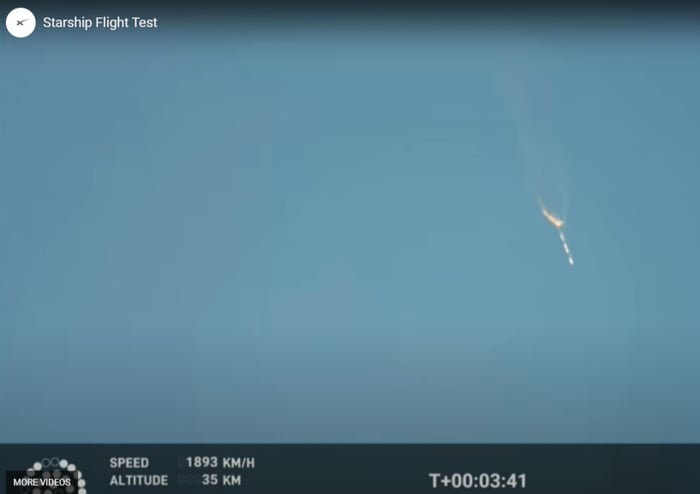On Thursday last week, shares of Tesla, Elon Musk's industry-leading electric car company, reported a dramatic decline in profits that cost the stock more than $50 billion worth of market capitalization. No sooner did that happen than Musk's other company, rocket builder SpaceX, attempted its first-ever test flight of a Starship spacecraft stacked atop a Super Heavy booster -- both of which proceeded to explode in midair less than four minutes after takeoff.
So I suppose you could say that Elon Musk had a bad day.
But on the other hand, it wasn't all bad.
Taking off from the SpaceX Starbase in Boca Chica, Texas, at 9:33 a.m. ET, the fully integrated Starship and Super Heavy rocket elicited applause as it successfully cleared its launch tower and proceeded to climb to an altitude of about 24 miles -- nearly half the distance to "space." Even at liftoff, however, there were hints that all was not well, with early photos showing three of the Super Heavy's 33 Raptor engines failed to ignite.

One second after launch. So far, so good. Image source: SpaceX.
Ultimately, at least five engines failed, and by about the third minute of flight, it became clear that this spaceflight was far from nominal (a term of are that basically means "everything went the way it was supposed to." The Starship stage failed to separate from the Super Heavy booster on schedule, and the entire rocket ship proceeded to lose altitude, began to tumble -- and was remotely detonated over the Gulf of Mexico to prevent an uncontrolled crash.

Uh-oh. Shouldn't that rocket be pointed up? Image source: SpaceX.
News media around the world leapt on the story, emphasizing the fact that the rocket exploded "midair" and "shortly after launch." And that's fair. It did explode. It didn't even get very far before exploding. In fact, the entire test flight lasted less than four minutes before SpaceX called it quits.
And yet, this isn't the end of the story for Starship (or SpaceX). In fact, it's much closer to the beginning.
Consider: Prior to Thursday's "fully integrated" flight test, SpaceX conducted a whole series of flight tests of the integrated rocket system's Starship second stage between 2019 and 2021. Starship flew, in various configurations, eight times (four "hops," followed by four free flights that exploded upon landing) before finally completing a successful landing of the SN15 prototype on May 5, 2021.
In fact, counting "tethered" hops in which the Starhopper testbed wasn't permitted to leave the ground, it took more than two full years of testing to prove that Starship could both fly and successfully land back on Earth.
What comes next
Space fans and space investors should expect something similar to follow Thursday's test flight. Already, Elon Musk has promised to conduct a follow-up test flight, building on data collected from Thursday's launch, "in a few months."
Congrats @SpaceX team on an exciting test launch of Starship!
-- Elon Musk (@elonmusk) April 20, 2023
Learned a lot for next test launch in a few months. pic.twitter.com/gswdFut1dK
And after that one (presumably) fails as well, there will be another test flight. And another. And another -- until ultimately SpaceX gets this right. In short, for the fully integrated Starship system, this process has only just begun.
What it means for investors
This is the point that much of the mainstream media seems to have missed last week: Not only is SpaceX all but certain to keep working this problem until it succeeds. It's also pretty clear that SpaceX can afford to build all the test-vehicles it will need to run the flight tests needed to get Starship right.
Consider that roughly two-thirds of the cost of any rocket system sits squarely in its engines. For SpaceX, a complete Super Heavy-and-Starship combination is powered by 39 Raptor engines. At an estimated cost of $1 million per engine, that works out to $39 million per test flight. Although it's hard to be 100% certain about these numbers, it sure sounds like each time SpaceX blows up a Super Heavy-and-Starship combination during testing, it's probably not spending much more than $60 million to do so.
Assuming these numbers are accurate, therefore, SpaceX could run through a dozen Starship "failures" and it would still cost less than 20% of the price that NASA is paying Boeing, Lockheed Martin, Northrop Grumman, and similar "old space" companies to launch a single Space Launch System rocket.
And when, after months or years of trying, SpaceX finally does get its Starship-Super Heavy megarocket straightened up and flying right? Well, a few years ago I tallied up all the costs of Starship-Super Heavy -- the cost of developing the system, of building it, of fueling it, and of flying it. Amortized across the entire program, it still came to an average cost of just a little over $2 million per flight for this fully reusable rocket system.
Competing against rival rocket launchers such as Europe's Ariane and America's United Launch Alliance, which are still charging nine-figure price tags for use of their disposable rockets, it's clear that once SpaceX succeeds in proving Starship-Super Heavy can fly, it's going to blow up the economics of spaceflight. It will quite literally -- and I don't use that word lightly -- render every other space company on Earth unprofitable relative to SpaceX.
So yes, the process of test flying Starship ended in failure last week. But the process has begun, and the end result is inevitable.




